Prosecutor: Man wrongly convicted of 1957 cold-case murder

By Ann O'Neill, CNN
Updated 6:09 PM ET, Fri March 25, 2016 | Video Source: WMBF
CNN)An Illinois prosecutor says he has found "clear and convincing evidence" that a former police officer was wrongly convicted of the 1957 murder of a 7-year-old girl in what is believed to have been the nation's oldest cold case to go to trial.
Jack Daniel McCullough, a 75-year-old military veteran and former police officer from Seattle, was convicted in 2012 of the abduction and murder of Maria Ridulph from a street corner in Sycamore, Illinois, a small farming community about 65 miles west of Chicago. A judge hearing the case without a jury found McCullough guilty after a weeklong trial.
Richard Schmack, the state's attorney for DeKalb County, said his review of the case led him to conclude that McCullough could not have committed the crime.
"... the People are ethically compelled and constrained to admit the existence of clear and convincing evidence showing Defendant to have been convicted of an offense which he did not commit," Schmack said in court documents.
McCullough has always insisted he was innocent.
"Look in the box. The truth is in the box," McCullough said at his sentencing, pointing to a cardboard box in the courtroom. It was filled with old FBI reports and other documents that the judge, James Hallock, barred the defense from presenting, saying it was inadmissible hearsay.
Schmack looked in the box. He said he spent six months reviewing about 4,500 pages of vintage police and FBI reports, and reconstructed the timeline surrounding the child's disappearance. He also turned up new evidence by subpoenaing AT&T phone records. He concluded that the alibi claimed by McCullough, who was then known as John Tessier, holds up.
It was impossible for McCullough to have committed the crime, Schmack said, because he was about 40 miles away in Rockford when Maria vanished.
"I truly wish that this crime had really been solved, and her true killer were incarcerated for life," Schmack said. "When I began this lengthy review I had expected to find some reliable evidence that the right man had been convicted. No such evidence could be discovered. Compounding the tragedy by convicting the wrong man, and fighting further in the hopes of keeping him jailed, is not the proper legacy for our community, or for the memory of Maria Ridulph."
A hearing in the case is scheduled for Tuesday in Sycamore.
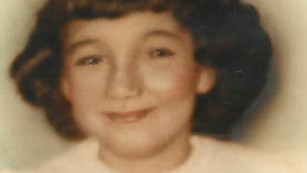
Read the original series: "Taken"
Maria Ridulph's murder went unsolved for half a century. Then bulldog detectives pursued a tip, and a man was brought to trial and convicted in the 1957 murder of the 7-year-old in Sycamore, Illinois. Now that man may walk free. Read Ann O'Neill's riveting, five-part exploration of the case, "Taken," published in 2013.
Schmack concluded that the Illinois State Police got the timeline wrong. There was no evidence to support the theory that Maria was taken as early as 6:15 p.m., as investigators claimed in an affidavit supporting the arrest warrant.
The Illinois State Police did not respond Friday to a request for comment.
Schmack pointed to the account of a fuel oil deliveryman, Tom Braddy, who placed Maria and her friend, Kathy Sigman, on the street corner closer to 7 p.m., and to the AT&T records that support McCullough's version of events.
"Thousands of pages of improperly excluded police reports more than 20 years old contain a wealth of information pointing to McCullough's innocence, and absolutely nothing showing guilt," Schmack said in a statement announcing his decision not to fight McCullough's request to overturn his conviction. Without resistance from prosecutors, McCullough likely could go free as early as next week.
Schmack told CNN his office notified the Ridulph and Tessier families by letter. The prosecutor also filed a lengthy report with the court, saying it was his ethical duty to take another look at the case, which was prosecuted by his predecessor, Clay Campbell.
"I know that there are people who will never believe that (McCullough) is not responsible for the crime," Schmack said. "Many of these people are my neighbors in Sycamore. But I cannot allow that to sway me from my sworn duty ... and to perform faithfully the primary duty of my office, 'To seek justice, not merely to convict.'"
Campbell called the decision a "travesty." He said he considered solving Maria Ridulph's murder to be his "life's work."
Charles Ridulph, Maria's older brother, told a local newspaper that Schmack's position was "ridiculous."
"A few months ago [Schmack] gave me a copy of his time frame, and I went through that and it just made me sick," Ridulph told the Daily Chronicle. "There's a reason that none of [the old police reports were] allowed into evidence to begin with, because there were so many discrepancies and you couldn't cross-examine it."
The Tessier family's reaction was not immediately known. But McCullough's wife, Sue, said she felt vindicated.
"I told you all this time. I told you he was innocent," she said, adding she was "feeling nervous and excited at the same time."
Sue McCullough, who lives in a seniors complex in Seattle, pointed out that her husband "hasn't lived here in five years" and said she was able to visit him once in prison in Illinois.
"We talk on the phone, and we write letters. If he was in there all alone and he had nobody to write to, it would have been so hard for him. I've been living all alone, and at first I didn't like it, but as the years go by, I get used to it. Not a word is spoken in this apartment except by me."
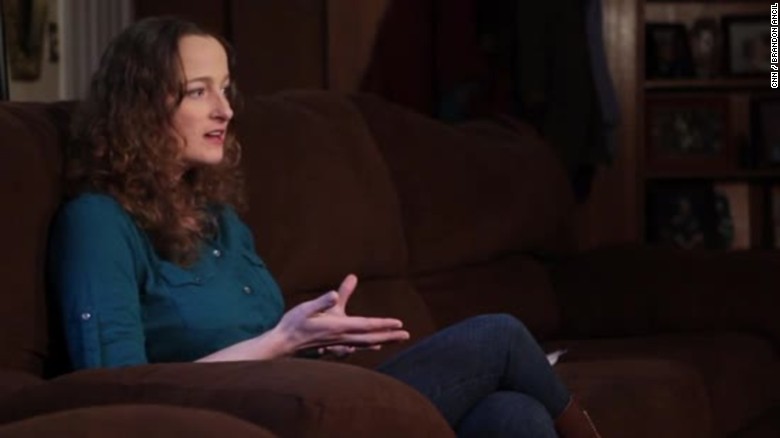
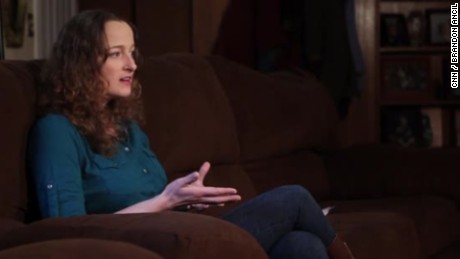
JUST WATCHED
Stepdaughter: He didn't do it
Replay
More Videos ...
MUST WATCH

Stepdaughter: He didn't do it 01:08
McCullough's stepdaughter, Janey O'Connor, has stood by McCullough. She and her husband, Casey Porter, plan to be in court on Tuesday. She praised Schmack for taking a second look at the evidence.
"This is bravery. This is courage," she said. "The whole town of Sycamore wants Jack to be guilty."
O'Connor said she had resigned herself to the reality that her stepfather would likely die in prison, convicted of a crime he didn't commit.
"I can't believe Jack made it to the end," she said. "We're still in that limbo where we say, 'OK, the prosecution and the defense are saying he's not guilty, but what do we do now?' "
She says Campbell and the Illinois State Police "decided Jack was guilty and built a case around it."
"If you don't have money, you just get ground up by the legal system," she added. "I would have never thought that this would be my life, but that's what can happen. It's terrifying."
McCullough has been held at the Illinois state penitentiary in Pontiac. He maintained his innocence in a prison interview with CNN in 2013. He insisted that the FBI questioned him and cleared him in 1957 because his alibi checked out. He couldn't be the killer, he insisted, because he was not in Sycamore when Maria was taken.
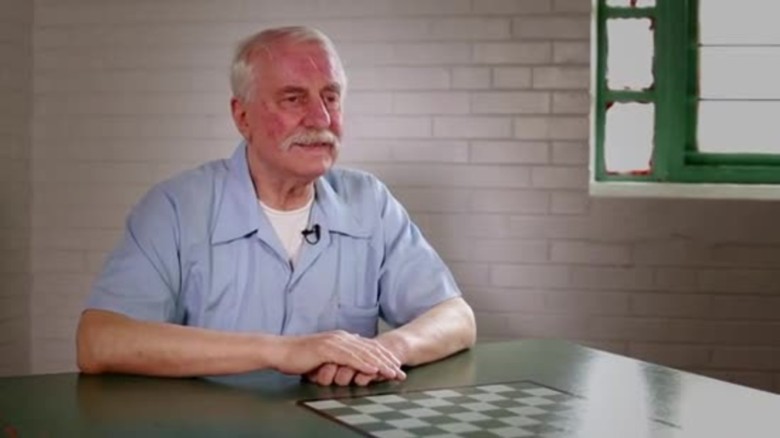
The subpoenaed AT&T phone records support McCullough's version of events. He said he called home, collect, to ask his father for a ride after meeting with U.S. Air Force recruiters in Rockford. The records show that a call was indeed connected from a pay phone inside at the old Rockford post office at 6:57 p.m. -- approximately the same time Maria vanished from the corner of Center Cross Street and Archie Place.
The child had been talking with a young man who called himself Johnny and who gave her a piggyback ride. Her disappearance shocked the close-knit farming community to its core and left Sycamore forever changed. Nearly three dozen FBI agents descended on the town of 7,000, looking in basements, storm drains, ponds, railroad cars and the trunks of cars. They interviewed dozens of people, including known sex offenders. FBI chief J. Edgar Hoover took a personal interest in the case, as did President Dwight Eisenhower.
Maria's body was found some five months later, near Galena, a small town just a few miles from the Iowa state line.
The case went unsolved for more than half a century. The Illinois State Police opened an investigation after McCullough's sister, Janet Tessier, called a tip line and repeated what their mother had said on her deathbed 14 years earlier: "Those two little girls, and the one that disappeared, John did it. John did it, and you have to tell someone."
As state's attorney at the time, Campbell brought the case, but was defeated by Schmack in an election just weeks after McCullough was convicted. While Schmack was a spectator during the trial, Campbell, by then a lame duck, was the spectator when McCullough was sentenced to life in prison.
Cold cases are particularly difficult to prosecute because evidence is often lost or destroyed, memories fade and witnesses die. And so doubt has lingered over the evidence used to convict McCullough -- and whether it was strong enough. No physical evidence ties him to the crime.
Instead, prosecutors relied on a revised timeline, the deathbed accusation by McCullough's mother as recalled by his sister, and an eyewitness identification by another child -- now Kathy Sigman Chapman -- who was playing with Maria in the snow shortly before she vanished.
Chapman responded to the latest developments through her husband, Mike: "We read the response and we're not surprised by his action. We believe it's politically motivated. It is an election year and he is running to be re-elected. Kathy got it right. It's sad it has come to this."
The defense was barred by hearsay limitations from presenting its own timeline because McCullough did not testify. Tom McCulloch, the public defender, had wanted to offer the 1957 FBI reports that cleared his client and supported his timeline. In Illinois, police reports are generally excluded and are not accepted as substitutes for live testimony.
Schmack said his parsing of an appeals court decision denying McCullough a new trial contained an eye-opening detail: The court found that while the FBI reports were inadmissible as "business records," they could have been included as "ancient documents" because they are more than 20 years old.
McCullough had nearly exhausted his appeals. He had convinced the appeals court to toss out his convictions for kidnapping and abduction of an infant on legal technicalities related to the age of the case. But his murder conviction stood as he lost at every turn in Illinois' appellate courts.
Late last year, McCullough turned again to the courts in Sycamore, filing a lengthy, handwritten appeal seeking a judge's declaration that he is innocent. He lost that, too, and the judge called the appeal "frivolous and without merit."
But public defendner McCulloch and his investigator, Crystal Harrolle, noted that the points he'd made "inartfully" were worth pursuing. They again took up his cause -- even though they were no longer appointed to represent him. They asked the court to reconsider, saying new evidence had come to light.
And that is what triggered the prosecutor's extraordinary response.
That "new" evidence cited by the defense lawyers included allegations of false promises made by prosecutors to fellow county jail inmates who testified against McCullough. But perhaps the most compelling discovery was the disputed statement of Jan Edwards, their client's high school girlfriend in 1957.
Schmack cites the dispute in his report to the court, but says it turned out to be just one of many issues he had with the case. Still, it signaled that he was taking a hard look at the evidence used to secure the conviction.
Edwards is Jan Swafford now, and she lives in Florida. The "new" evidence includes what she said during a taping of a "Dr. Phil" show about the case. She was in the audience, and insisted that she may have seen McCullough on the night Maria disappeared.
In an exchange of letters with Schmack, she said she never told investigators that she didn't see McCullough that night. And she insisted she never told the investigator that her father had forbidden her to leave the house.
She was brought to Sycamore but never testified at the trial. She said she was eager to tell her story but "never had the chance."
The defense alleged that prosecutors should have disclosed the discrepancy but instead hid Swafford from them during the trial.
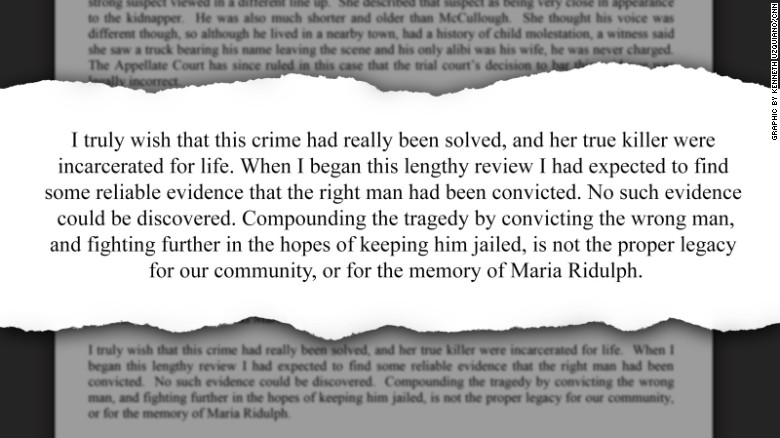
From the press release of Illinois state's attorney Richard Schmack, who spent six months reviewing the case.
Her correspondence with Schmack was attached to a legal motion filed last fall. The prosecutor initiated the conversation in a letter dated November 6, 2014 -- shortly after the case was featured on the "Dr. Phil" show. Schmack opened his letter by taking pains to point out that he was not involved in the initial prosecution but would be tasked with making any decisions should the conviction be reversed.
"When you appeared on the 'Dr. Phil' show a few weeks ago, you gave a brief account of contact you had with Mr. McCullough on the night of the Ridulph kidnapping," Schmack wrote. "This account seemed more consistent with the defense theory of the timeline than the prosecution. I was surprised you were given so little time to explain and that no questions were posed to you."
He pointed out that what she said on the show was "entirely inconsistent" with an Illinois State Police investigator's "field notes" memorializing their telephone conversation. The report stated: "Jan stated the night Maria was kidnapped her parents would not let her leave the house at all, not even to go on date, she does not recall John coming to her house that night."
Four days later, Swafford responded, sending her letter by fax. She said she was "greatly disturbed" by what Schmack said was in the investigator's report.
"It is completely the opposite," she wrote. "I never did say he wasn't with me that night or that Dad wouldn't let me out of the house. What I did say is, 'I can't confirm the exact date that my recollection happened, but he came over around 9:30 p.m. as we had planned.'"
She added that he didn't stay long because she had a curfew. They talked outside, in a car, she added. "He said he was very happy and excited because he had just passed his test for the Air Force and he will be able to get into it. He asked me to hold the train ticket for him so he wouldn't lose it.' That was it. We talked for a while and he went home."
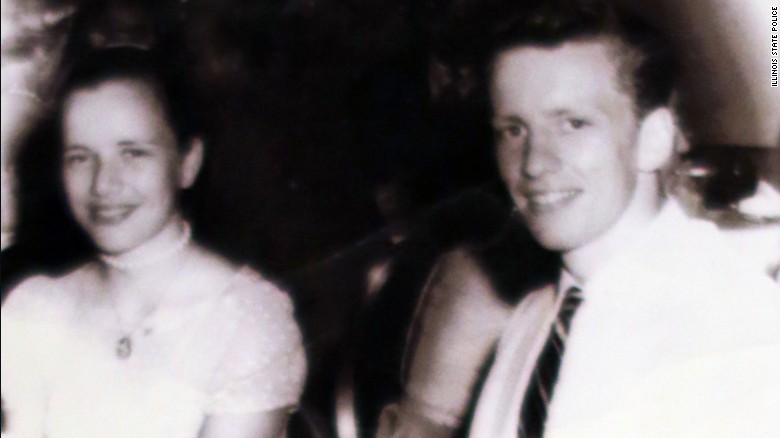
McCullough, then John Tessier, with high school girlfriend Jan Edwards, now Jan Swafford, at a formal dance.
At the time of McCullough's arrest, attention focused on the train ticket as a "smoking gun" in the case. But in the end, it bore little relevance because it had never been punched.
Swafford said in her letter to Schmack that she has tried to ignore the false reports, many of which focused on a train ticket. "It sounds like they just wanted to make an interesting story about it and get a conviction," she wrote.
"All I know is what I know to be true," she continued. "My memory of that night has never changed, and I have tried to ignore all of the newspapers' versions of what I said and just try to stick to what I actually remember."
Schmack assured her that he wouldn't expect her to remember everything that happened on that night in 1957, but added, "My job is primarily to seek justice." He said her "recollection of the events" as well as her more recent recall of her dealings with police and former prosecutors "may be of great assistance in that endeavor."
CNN's Brad Parks contributed to this story.
Above is from:http://www.cnn.com/2016/03/25/us/oldest-cold-case-conviction-overturned-maria-ridulph-taken/index.html









